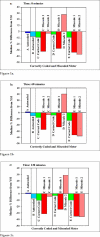Significant insulin dose errors may occur if blood glucose results are obtained from miscoded meters
- PMID: 19888408
- PMCID: PMC2771463
- DOI: 10.1177/193229680700100211
Significant insulin dose errors may occur if blood glucose results are obtained from miscoded meters
Abstract
Objective: The objective of this study was to determine inaccuracies of miscoded blood glucose (BG) meters and potential errors in insulin dose based on values from these meters.
Research design: Fasting diabetic subjects at three clinical centers participated in a 2-hour meal tolerance test. At various times subjects' blood was tested on five BG meters and on a Yellow Springs Instruments laboratory glucose analyzer. Some meters were purposely miscoded. Using the BG values from these meters, along with three insulin dose algorithms, Monte Carlo simulations were conducted to generate ideal and simulated-meter glucose values and subsequent probability of insulin dose errors based on normal and empirical distribution assumptions.
Results: Maximal median percentage biases of miscoded meters were +29% and -37%, while maximal median percentage biases of correctly coded meters were only +0.64% and -10.45% (p = 0.000, chi(2) test, df = 1). Using the low-dose algorithm and the normal distribution assumption, the combined data showed that the probability of insulin error of +/-1U, +/-2, +/-3, +/-4, and +/-5U for miscoded meters could be as high as 49.6, 50.0, 22.3, 1.4, and 0.04%, respectively. This is compared to manually, correctly coded meters where the probability of error of +/-1, +/-2, and +/-3U could be as high as 44.6, 7.1, and 0.49%, respectively. There was no instance of a +/-4 or +/-5U insulin dose error with a manually, correctly coded meter. For autocoded meters, the probability of +/-1 and +/-2U could be as high as 35.4 and 1.4%, respectively. For autocoded meters there were no calculated insulin dose errors above +/-2U. The probability of insulin misdosing with either manually, correctly coded or autocoded meters was significantly lower than that with miscoded meters. Results using empirical distributions showed similar trends of insulin dose errors.
Conclusions: Blood glucose meter coding errors may result in significant insulin dosing errors. To avoid error, patients should be instructed to code their meters correctly or be advised to use an autocoded meter that showed superior performance over manually, correctly coded meters in this study.
Keywords: Monte Carlo simulation; autocode; autocoded blood glucose meter; blood glucose; blood glucose meter; insulin dose error; manual code; miscoded meter; self-monitoring of blood glucose; user error.
Figures


References
-
- Winter WE. A Rosetta stone for insulin treatment: self-monitoring of blood glucose. Clin Chem. 2004 Jun;50(6):985–987. - PubMed
-
- Skeie S, Thue G, Nerhus K, Sandberg S. Instruments for self-monitoring of blood glucose: comparisons of testing quality achieved by patients and a technician. Clin Chem. 2002 Jul;48(7):994–1003. - PubMed
-
- Batki AD, Thomason HL, Holder R, Nayyar P, Thorpe GHG. 2002. May, TheraSense FreeStyle blood glucose meter: Medical Devices Agency Evaluation Report. MDA Report No. 02049.
-
- Baum JM, Monhaut NM, Parker DR, Price CP. Improving the quality of self-monitoring blood glucose measurement: A study in reducing calibration errors. Diabetes Technol Ther. 2006 Jun;8(3):347–357. - PubMed
-
- Using blood glucose meters minimizing errors, maximizing accuracy [guidance article] Health Devices. 2004;33:251–256. - PubMed
LinkOut - more resources
Full Text Sources
Other Literature Sources
Miscellaneous

